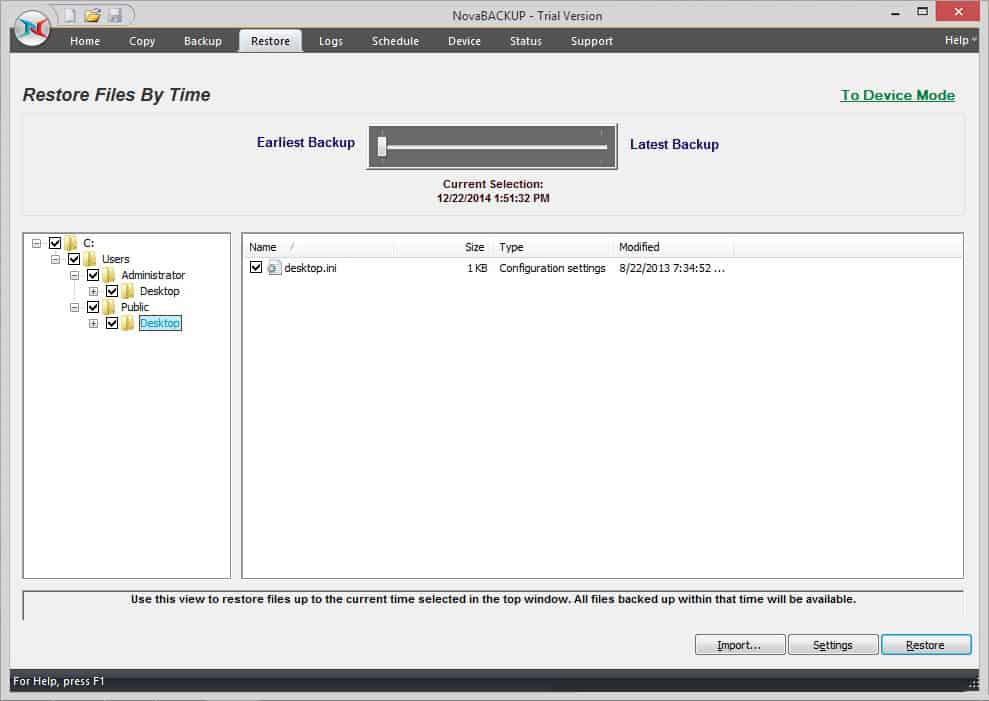Share this
Breakthrough Approach to File Restoration
by Bridget.Giacinto on Jan 14, 2015 5:58:47 PM
If you have ever wanted to restore a file from a backup, but forgot which backup device you saved it to, or if you have ever wanted to restore a file from a specific point in time, there is a simple solution.

NovaStor was just awarded a patent for a time slider technology that represents a breakthrough in data restoration. This technology gives users the ability to restore files, regardless of when or where the files were backed up.
 Patented time-slider technology for file restoration.
Patented time-slider technology for file restoration.File Restoration Use-Case #1
A perfect use-case for this new technology would be a situation where you are familiar with the file name, but not 100% certain of where the file is located. By using filters, you could easily enter the file name or names (with or without the use of wildcards) and then use the time slider to specify if they want the latest backup (default option) or an earlier backup, by simply moving the slider from right to left. You can also specify if you would like to restore files to the original location or an alternative location, and select if you want to overwrite existing files or not, giving you complete control of the data restoration.
You can also quickly determine what backup device a file is saved on by simply right-clicking on any file while you are in the time-based restore mode. This technique will also allow you to view all of the version information available for the specific file, along with the size, date, and time that file was backed up. Since you can restore more than one version of that file, you could look at this as a version history option. By default, the latest version of the file or files will be restored as most users will want the most updated version to restore from. But that is not always the case, as in the next example.
File Restoration Use-Case #2
If your computer was infected with a virus or ransomware, like CryptoLocker, where your data was encrypted and held at ransom (unless of course, you want to pay off the hackers), thus rendering it useless, you may not want the most current backup. If for instance, your system had run a backup automatically (based on the previous backup schedule you had in place) after your computer was infected with the virus, you would not want to restore those files, instead, you would want to be able to essentially roll-back to before the malicious virus attacked your computer and hijacked your files. The beauty and simplicity of this feature lie in the fact that as long as the file or files reside in the restore options GUI, you don’t need to know which device or devices the data is stored on, as this patented technology will still be able to retrieve the data you want based on the time frame you want.
How Does this Technology Work?
This is a patented technology, so let's just review the general concepts behind how this technology works. To start, NovaBACKUP is aware of every file it has ever backed up to any local or online destination and can query the online storage servers that NovaBACKUP is set up to use to see what files and dates are listed on the online storage server. After the data has been gathered, each file is indexed, noting where the file has been backed up, when it was backed up and the different metadata included on the file for each backup that was completed. When the slider is moved, the underlying framework changes the parameters of what should be displayed. Once a user selects a file, and instructs NovaBACKUP to restore, NovaBACKUP creates a list of all of the files and pieces of media or locations where it needs to grab each file that was selected and then runs a job to restore each file from the correct location. If you would like to test this technology yourself, you can download the latest version of NovaBACKUP and try it for yourself.
Abstract from Patent
U.S. Patent No. 8,903,773 B2 - Computer file storage, backup, restore and retrieval is disclosed. A method includes providing a restore file interface allowing a user to restore a plurality of files based on a plurality of filter options, the files stored on multiple local and/or remote storage devices, computing devices, servers and clouds. A filter option selection is received from the user, and filter details may also be received from the user. An available file list may be prepared based on the filter option selection and, if received, the filter details. A user selection from the available file list may be received. The user selected files are retrieved from one or more appropriate storage devices, computing devices, servers and clouds. The method may be performed by software executing on a computing device.
Share this
- Pre-Sales Questions (112)
- Tips and Tricks (95)
- Industry News (60)
- Reseller / MSP (37)
- Security Threats / Ransomware (29)
- Applications (28)
- Best Practices (26)
- Cloud Backup (25)
- Backup Videos (24)
- Disaster Recovery (24)
- Compliance / HIPAA (23)
- Storage Technology (21)
- Virtual Environments (17)
- Technology Updates / Releases (9)
- Infographics (8)
- Backup preparation (3)
- Company (US) (1)
- Events (1)
- Events (US) (1)
- Products (US) (1)
- March 2024 (2)
- February 2024 (2)
- January 2024 (1)
- December 2023 (1)
- November 2023 (1)
- October 2023 (1)
- September 2023 (1)
- August 2023 (1)
- July 2023 (1)
- May 2023 (1)
- March 2023 (3)
- February 2023 (2)
- January 2023 (3)
- December 2022 (1)
- November 2022 (2)
- October 2022 (2)
- September 2022 (2)
- August 2022 (2)
- July 2022 (1)
- June 2022 (1)
- April 2022 (1)
- March 2022 (2)
- February 2022 (1)
- January 2022 (1)
- December 2021 (1)
- November 2021 (1)
- September 2021 (1)
- August 2021 (1)
- July 2021 (1)
- June 2021 (2)
- May 2021 (2)
- April 2021 (1)
- March 2021 (2)
- February 2021 (1)
- January 2021 (2)
- December 2020 (1)
- November 2020 (1)
- October 2020 (2)
- September 2020 (4)
- August 2020 (2)
- July 2020 (1)
- June 2020 (1)
- May 2020 (1)
- April 2020 (1)
- March 2020 (3)
- February 2020 (2)
- January 2020 (2)
- December 2019 (1)
- November 2019 (1)
- October 2019 (1)
- August 2019 (1)
- July 2019 (1)
- June 2019 (1)
- April 2019 (1)
- February 2019 (1)
- January 2019 (1)
- December 2018 (1)
- November 2018 (2)
- August 2018 (3)
- July 2018 (4)
- June 2018 (2)
- April 2018 (2)
- March 2018 (2)
- February 2018 (2)
- January 2018 (3)
- December 2017 (1)
- September 2017 (1)
- May 2017 (2)
- April 2017 (5)
- March 2017 (4)
- February 2017 (1)
- January 2017 (1)
- December 2016 (1)
- November 2016 (1)
- October 2016 (2)
- September 2016 (1)
- August 2016 (3)
- July 2016 (2)
- June 2016 (3)
- May 2016 (7)
- April 2016 (8)
- March 2016 (1)
- February 2016 (3)
- January 2016 (12)
- December 2015 (7)
- November 2015 (6)
- October 2015 (6)
- September 2015 (2)
- August 2015 (4)
- July 2015 (2)
- June 2015 (2)
- May 2015 (1)
- April 2015 (5)
- March 2015 (3)
- February 2015 (4)
- January 2015 (2)
- October 2014 (5)
- September 2014 (8)
- August 2014 (5)
- July 2014 (8)
- June 2014 (5)
- May 2014 (5)
- April 2014 (9)
- March 2014 (7)
- February 2014 (7)
- January 2014 (5)
- December 2013 (5)
- October 2013 (7)
- September 2013 (2)
